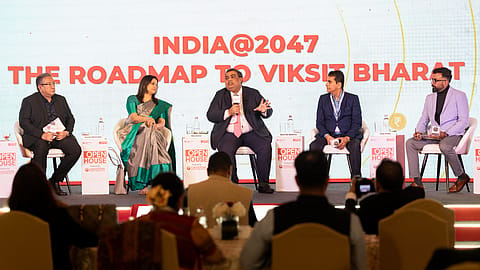Top industry voices speak about India's path to becoming 'Viksit'
The few pillars such as investment, consumption and demographics are all falling in place.

As India progresses on its path to become a developed nation by 2047, members of a panel on 'India @ 2047: The Roadmap to Viksit Bharat' at Open House, expressed confidence in the country’s growth prospects while reiterating that all engines must fire on the journey to ‘Viksit Bharat’.
Barnik Maitra, Managing Partner, Chrysalis Capital, says all engines of the economy--domestic consumption, public investment, private capital formation, and exports--should be firing if the country has to grow at 8%.
Ritu Arora, CEO & CIO Asia Pacific, Allianz Investment Management, is convinced that India is poised to be a very large global economy. “It’s not a matter of if, it’s only a matter of when. The journey is well laid out. But it is unprecedented in some ways. China’s economy doubled every three years. Will it play out like that for India? One cannot be sure. The few pillars such as investment, consumption and demographics are all falling in place,” says Arora, adding that the country is on the right path with technology as an added ingredient.
Market veteran Vijay Kedia, however, believes that 8% GDP growth is not going to take the country to the Viksit Bharat level by 2047. “For that, we have to grow a lot more.”
On the rise of artificial intelligence, Arora says it will not impact jobs. “AI is a great enabler and a great disruptor. Now, even the common man understands and is talking of AI. AI is a game changer. When we were coming into the workforce, there was a discussion on computerisation--that it would take away jobs. But what happened was creation of value-added jobs,” Arora says, adding that AI will do the same in a matter of seconds. “AI is a marathon race. India is well poised.”
Veteran investor Kedia believes that India is not late to the AI race despite China’s DeepSeek and US’s Nvidia and OpenAI leading the space. “What happened in IT services makes me believe that we will catch up with the rest of the world and become a leader in AI,” says Kedia.
On the new income tax regime offering tax cuts to the middle class, Maitra says India’s growth story rests on the common man. “They're probably the largest tax cuts after 30 years. ₹1 lakh crore of tax foregone will now be in the hands of customers. The Indian consumer should be confident to spend this money. Consumption is 55-60% of India’s economy. For FMCG companies, there were distressing signs that something was wrong with urban consumption. We should start seeing private capital come into several sectors,” says Maitra.
Recommended Stories
Arora is also betting on consumption to drive economic growth. “We used to be a 40% savings economy. We are now 20%. It’s good. Many large economies have a consumption rate that outdoes the savings rate. It is healthy for the economy. By putting more money in the hands of people, they spend on health, education, etc.. We are a young country. The beneficiaries are the youth. The multiplier effect will be more than is anticipated,” says Arora.
She also welcomed the government’s move of raising the FDI limit in insurance to 100%. “We have around 25 players in insurance which is small for a country of India’s size. This will take insurance and financial products to the last mile,” she says.
Kedia, however, cautioned that just a tax rebate is not going to solve India’s problems. India needs to create 1 crore new jobs every year, he says.
Agrees Maitra of Chrysalis Capital, saying that India needs to create 10 crore jobs. “The jobs will get created when there is capacity addition. The contribution of the manufacturing sector to GDP was 16% in 2013-14. Now, manufacturing is barely 15%. We are adding far less value in manufacturing. The emphasis should be on quality of jobs which add value and increase disposable income,” says Maitra. Jobs can be created only when private capital comes in, he adds.
(INR CR)